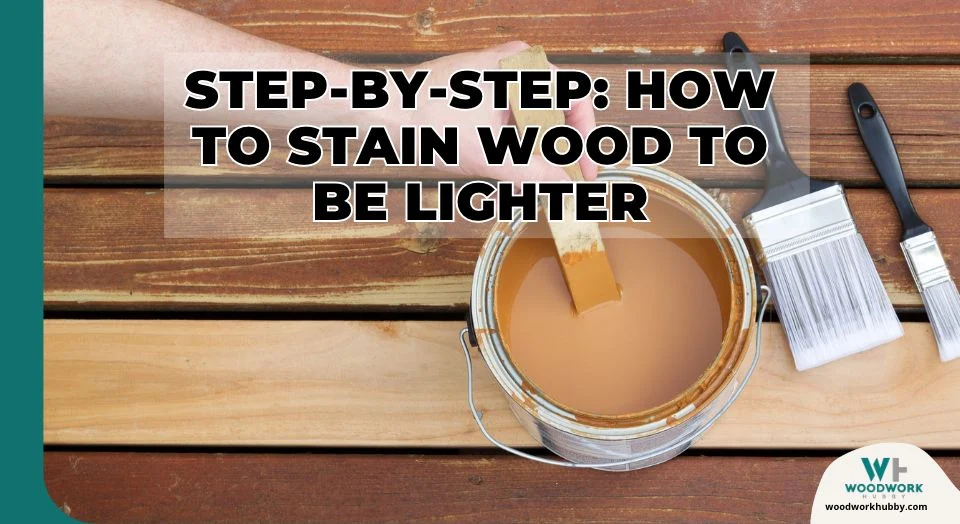With wood in high demand, I have found it quite difficult to source the right color wood for some of the more particular projects. Maybe you have this problem or you just applied too much of a dark stain and you have changed your mind. Either way, I will cover exactly how to stain wood to be lighter in this article.
As a general rule, wood can be stained lighter by either bleaching it to lighten a darker wood grain or applying a chemical agent to remove a dark stain that may already be in place. Both options are quite simple to do and only require a few basic tools.
In the sections below, we are going to give you several alternatives to choose from and step-by-step guides for each. You can find a wide variety of strippers, removers, and other agents that are capable of lightening a stain by a few shades. Very dark stains or ones that penetrate deep into the wood may require additional measures like sanding.
How Do You Change Dark Wood to Light?
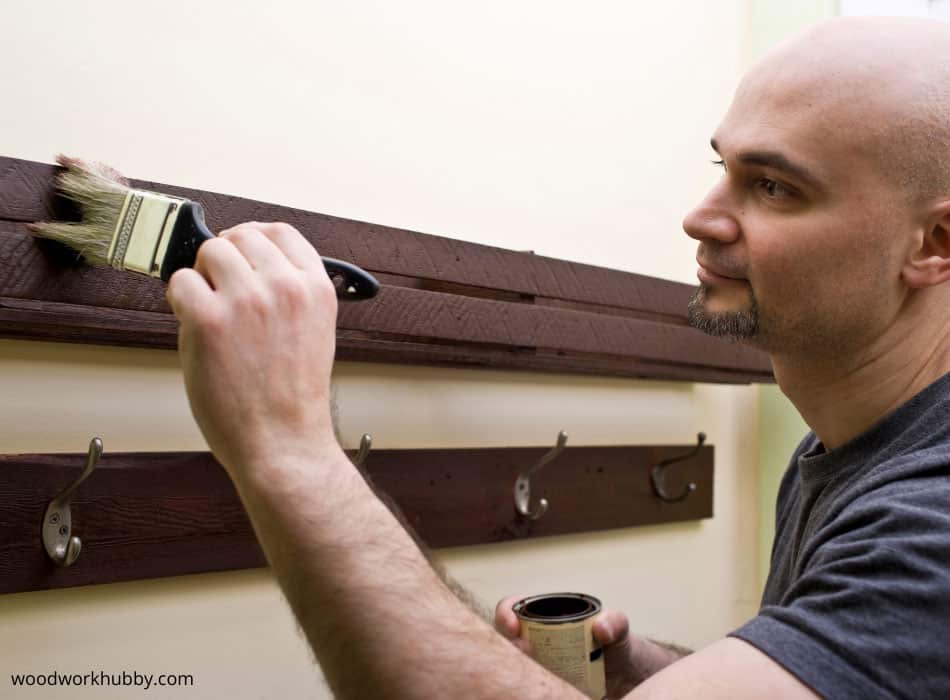
The process of how to stain wood to be lighter is straightforward and requires only a few specialized tools. Usually, it takes wood less than an hour for moderately-sized items to be transformed using an off-the-shelf stain remover.
You may need the following items depending on how you intend to make the wood more light in appearance.
- Wood bleach, stain remover, or stain stripper of your choice
- Safety equipment for working with chemicals including gloves, eyewear, and mask or respirator
- Large paintbrush
- A tool for scraping away at peeling paint and finish
- Steel wool sponge or microfiber cloth
- Sandpaper, electrical sander, or sandpaper block
Because you will be choosing whichever option is designed for the type of stain you have to remove, it is likely that you will need one or all of the items listed above to avoid damaging the wood. Did you apply too much stain? – My full breakdown here will help
Determine the Type of Stain
Before you can choose which method will work best for getting rid of the darker color, you need to have a clear understanding of what you are dealing with. There are quite a few types of stains, and they each have unique properties that might impact your ability to manipulate the color of the wood.
If you are the one who finished the wood, then the best thing to do is try to find the stain you used when you were working on it.
The Woodworkers Guild of America helped me out a lot while learning about stains. Be sure to check out my article here where you can find out if it was worth it.
You can always look up the product online if you no longer have the container. There should be information provided on the packaging or the manufacturer’s website that explains the best way to remove that specific stain.
The Different Wood Stain Mediums
If you are not sure what type of stain you are dealing with, then it is not always easy to figure out by simply eyeballing how it looks. You will want to try and identify what stain was used because each has its own strengths and weaknesses. Below are some of the most popular wood stains and what sets them apart.
- Varnish and Oil-based Wood Stains: these kinds are easily the most common. They tend to penetrate much deeper into the wood, which means stripping off only the surface layer may not be enough. There is usually some form of resin to bind the oil to the wood, which might require sanding to remove. The best method for eliminating an oil-based stain is to start with a wood stain remover and then finish it off with some sanding if necessary.
- Water-Based Stain: due to their quick drying and other factors, water-based stains do not penetrate very deep into the wood, making them easier to remove. The best method for getting rid of a dark water-based stain is to use a water and bleach or vinegar mixture and then lightly sand the surface after it has dried.
- Gel Stain: gel-based stains are another popular option, and they luckily do not penetrate too far into the wood fibers, which means you can try a number of methods for removing it, including using a heat gun, thinner, stripper, or sanding the area.
- Lacquer Wood Stain: this type of stain is often used in higher-quality wooden products, and it tends to soak deep into the wood, making it harder to lighten. The best method for removing it is to use a lacquer thinner and lightly sand. Over time, lacquer can cause odd spots of discoloration, so you may not be able to create an even color if the item has experienced this issue.
- Metalized Dye Stain: these fast-drying stains can be removed by stripping off the surface layer and then using a sponge and vinegar-water mixture to soak into the wood and lighten the color.
Can You Put a Lighter Stain Over a Darker Stain?
A lighter stain will not lighten your darker stain and therefore should not be used over the top. You will need to strip the darker stain off before applying a lighter one.
If you do not take these steps, then the darker color will stay underneath the lighter stain, and you will simply have a new dark shade of color because stains are not opaque.
Once you choose a stain remover and get rid of all or most of the original darker color, then you can refinish it with your preferred lighter stain. Most stains can be successfully removed using a petroleum-based solvent or homemade water-chemical mixture.
How to Choose the Right Products
When removing a dark stain, you want to make sure you are using products designed for what you are doing. For example, if you use a chemical paint stripper to remove a surface layer of dark stain, you might get inconsistent results and see discoloration of the wood.
Always read the manufacturer guidelines for any product before you purchase it to make sure that it applies to your needs.
When in doubt, you can check the recommendations provided by the stain creator to see what removers they believe will work best with their product. This is not always possible if you did not apply the stain yourself, but there are some generalizations you can use if you know the type of stain used.
Bleach is often used to remove darker stains and the best bleach to use is either oxalic acid or laundry bleach because they will lighten the wood without damaging the fibers or causing areas of uneven color.
You will want to do some research on the wood if you intend to use bleach because some woods like cherry, rosewood, cedar, and redwood do not react positively to bleaching.
How Can I Make Dark Wood Floors Lighter?
Dark wood floors can be bleached to achieve a lighter finish although you must thoroughly test on a scrap piece before applying it to your floor.
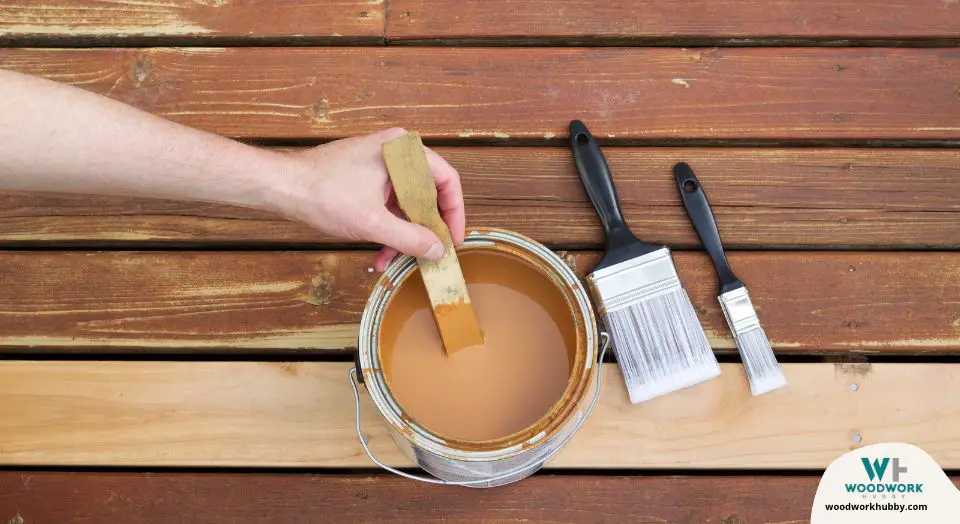
The exact step-by-step instructions for how to stain wood to be lighter are listed below and can be applied to flooring, furniture, and other wooden items. We have provided several options so that you can use whichever is most convenient for you.
There are a few pros and cons to consider with each. For example, you could bleach the wood to lighten a stain, but the type of bleach you use is vital because the wrong one could discolor the wood beneath permanently. Be familiar with the stain you are altering, the type of wood you are working with, and any substance you are using.
How to Prepare the Wood
You will need to prepare a few things regardless of what method you ultimately use to lighten the wood. They include the following.
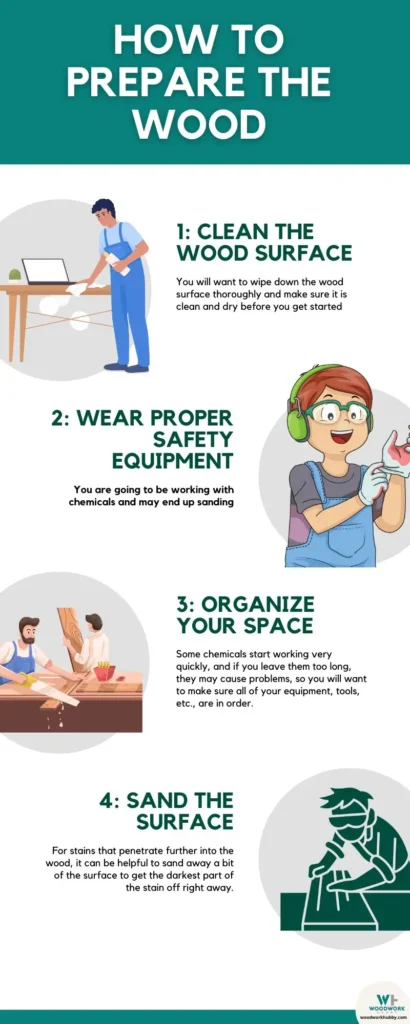
- Clean the Wood Surface: you will want to wipe down the wood surface thoroughly and make sure it is clean and dry before you get started. Some methods require sponging on warm water mixtures to help break down the stain, but the wood should be clean from dust and debris before you do that. A dry or lightly damp microfiber cloth works well for this step.
- Wear Proper Safety Equipment: you are going to be working with chemicals and may end up sanding, so you should have an appropriate mask even if you will be working outdoors or in a highly ventilated area. Gloves are also important because some stain removers have caustic chemicals that can cause rashes or burns if they come in contact with your bare skin. For this same reason, eyewear is essential when you are working with chemical solutions. You can purchase all necessary safety equipment at your local hardware store or online.
- Organize Your Space: some chemicals start working very quickly, and if you leave them too long, they may cause problems, so you will want to make sure all of your equipment, tools, etc., are in order. You need to know where everything is before you get started so that you can move smoothly through each step of the process.
- Sand the Surface: for stains that penetrate further into the wood, it can be helpful to sand away a bit of the surface to get the darkest part of the stain off right away. Sandpaper, an orbital sander, or a sandpaper block all work well for this step. For some surfaces such as floors or furniture, sanding down the stain might be all you need to do to lighten it.
How to Chemically Lighten a Stain With Bleach
You will want to use laundry bleach or other forms that are not going to adversely affect the wood’s integrity or leave behind uneven color variations. Wood bleach is ideal.
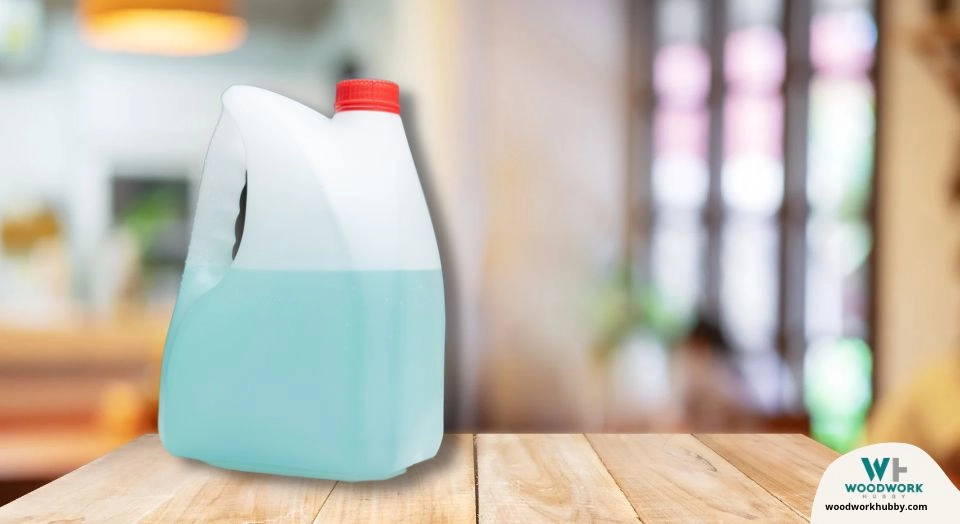
- Dampen a sponge or cloth with the bleach product of your choice.
- Wipe away at the stain or wood discoloration using smooth motions following along the grain of the wood.
- You can apply multiple layers of bleach until you reach the shade that you desire.
- Always check the final finish by using a scrap piece first to make sure you are happy with the final finish
Step-by-step Instructions For Sanding Away a Dark Stain
Sometimes wood develops unsightly dark splotches due to weathering, badly applied stains or other issues. You can sand down that area to get a flawless surface look.
- The wood should be entirely dry before you get started.
- Use approximately 100 to 150-grit sandpaper to remove the stain.
- Apply even pressure throughout to keep the surface smooth. Larger wooden items might require an electric sander.
- Remove the excess dust and apply a light coating of mineral spirits to highlight how the final finish will look
- Mineral Spirits dries off really quickly and is only used as a way to test how the finish will look once it on there.
Using White Color Wash
You can significantly lighten wood by applying a 2:1 mixture of water or turpentine and white paint. A thin layer of white color wash is all you need to lighten the wood significantly. This can go over a dark stain or naturally dark wood to create an effect that leaves the wood looking brighter.
White color wash is not going to look like natural wood color, so you should not use this if you want your item to look like natural light wood.
- Remove paint, stain, or varnish by using a chemical stripper and/or sanding.
- Use a damp cloth or sponge to clean the surface and remove any wood chips or other debris.
- Dilute the white paint with a 2:1 ratio of water or thinner to paint. For water-based paint, dilute it in water. For oil-based paint, you can use turpentine or a paint thinner.
- Apply evenly.
- Sand lightly between layers of whitewash until you achieve the desired look.
Additional Stain Remover Products
There are hundreds of brands and products to choose from, so no matter what kind of wood or stain you are dealing with, there will be a perfect stain remover option available.
Gel-Based Stain Remover
For gel-based stains, you can use chemicals that are meant to dissolve the gel and remove the unwanted color. It is very easy to use.
- Wear proper safety equipment and make sure you do not have exposed skin that could interact with the chemicals.
- Place some of the gel-based stain removers on a lightly damp cloth.
- Rub the wood surface in a vigorous circular motion until the stain dissolves.
Stain Strippers
You will want to use the stripper recommended by the manufacturer of the stain. Sometimes this information is not provided with the stain, in which case you can pick a stain stripper designed from the type of stain you have (e.g., gel-based, oil-based, etc.).
- You can use a heat gun or warm damp cloth to loosen the stain and then scrape it away with a putty knife or other tool.
- Apply a thick coat of stripper evenly across the wood surface and follow any instructions.
- Make sure the stripper stays wet because it will not work properly if it begins to dry out.
Lighten a Dark Stain Before Applying It To Your Project
While there are a number of methods for turning a finished stain lighter, you can also do a few things to keep stains from darkening after application. If you are trying to achieve a very specific shade, then you can test out your stain on a very small section of the wood to see how it will change as it dries and soaks into the wood.
You can then adjust the stain based on these results by adding darker or lighter color tones until you achieve the desired hue.
It should go without saying that the natural color of the wood you are using will impact the look of the stain once it is fully applied and dried. You may need to use several layers, or you may need to mix several shades of stains together to reach the right color. There are stain kits you can buy that come in a range of colors. Below are a few examples.
How to Lighten Naturally Dark Wood
Many woodworkers use naturally dark woods specifically so they can play with the unusual color, so it is rarely covered up. However, if you want a lighter appearance to your wood item, then there are some things you can do to change the color of the wood, including the following.
- Use wood bleach
- Sand to remove any surface discoloration or color flaws caused by weathering
- Whitewash with diluted paint
Fully Removing Stains From Smaller Wood Objects
You are now familiar with several straightforward ways to lighten wood, but in some cases, you may want to entirely remove a stain from smaller wooden objects. This is easier to do by sanding, but that requires a certain thickness to accommodate for the loss, and it works best on furniture or flooring, not delicate items.
You could use a strong chemical stripper designed for whatever stain is currently on the wood. Unfortunately, some wood may soak up the stain deep enough to make it hard for a stripper to get all of it out.
You can try the following method if you want to return a smaller wooden object to its original color or noticeably lighten it.
Use a heat gun to soften the stain and then remove it with a damp steel wool sponge or another tool. Darker stains may require additional gentle scrubbing and very light sanding.
Be careful always to use safety equipment when operating a heat gun and do not focus the heat too close to the wood; otherwise, you risk charing it.
Ways to Avoid a Stain That is Too Dark
You can take preventative measures to avoid a too-dark stain color including checking the finished appearance by using the stain on a very tiny piece of the wood to test it out. You also want to ensure you are using the right type of stain.
For example, if you make an outdoor bench, you want a product that will properly seal and stain the wood while keeping it weatherproof to avoid color changes due to humidity or rot.

